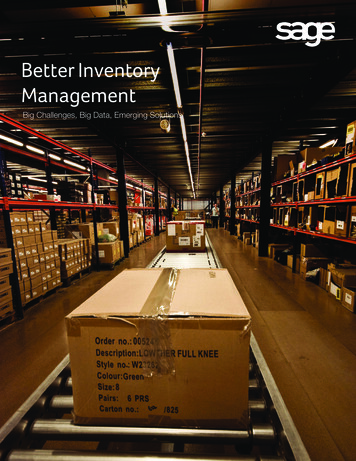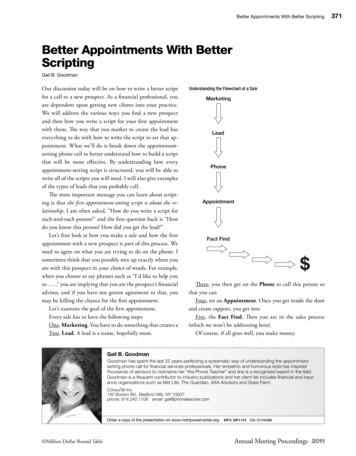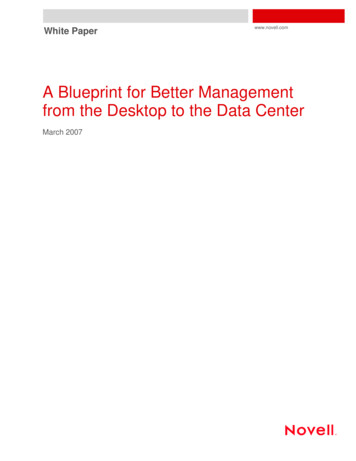
Transcription
Better InventoryManagementBig Challenges, Big Data, Emerging Solutions
Table of ContentsThe Challenge. 3A Multifunctional Process. 4Physical. 4Planning . 4Optimization. 5Making Better Use of Big Data. 6Analyzing and Forecasting Tools Gain Strength . 6Analysis. 6Forecasting. 7Management. 7Optimized Inventory Levels Based Upon Better Decisions. 7Conclusion. 8References. 92Better Inventory Management
The ChallengeBecause inventory is usually one of the biggest numbers on their balance sheet, effective inventorycontrol and management is a vital function to help insure the continued success of distribution andmanufacturing and companies. The effectiveness of inventory control is typically measured by howsuccessful a company is at reducing inventory investment, meeting its customer service goals, andachieving maximum throughput and cost containment.On paper, the concept of inventory management seems easy enough. In simple terms, it can besummed up as the process of determining what items to stock, how many of each item should bekept on hand, and when orders should be placed for more.Unfortunately, inventory management is much more complex in practice. The factors thatcomplicate the process fall into two broad categories: 1) conflicting objectives across varioussegments of each company, and 2) the tentative nature of both supply and demand.In the case of conflicting objectives, some parts of a business seek to increase inventory and otherparts to decrease it. For example, because the sales department prioritizes the delivery of productsin the best time frame to satisfy customer demand, they encourage the business to keep finishedgoods stocks high. The purchasing department achieves volume discounts on large batch andoff-season purchases, and this increases inventory. Production wants all parts and raw materialsto be available to keep line efficiency high and run large batch sizes, again increasing inventory.Conversely, product developers and finance department trend watchers often want to keepinventory low to advance the roll-out of new products. And most importantly, senior managementwants to decrease inventory, because sitting on stock ties up cash flow. Each part of the companyhas the same goal—better profitability—but differing viewpoints on how to get there.In the case of supply and demand, difficulties stem from unpredictability. For instance, unsteadysupplier performance, supply chain disruptions, scarcity of materials, the perishability andobsolescence of products, and shrinkage contribute to the need to establish buffer stocking levelsto provide safety days of lead-time supply. On the demand side, the overall economic environment,new products and innovations, and high-traffic sales volume for some items and sporadic orseasonal sales traffic for others necessitate the institution of a mixed approach to item-by-itemstocking levels.For distributors and manufacturers, the above factors are complicated further when hundreds ofthousands of finished goods for sale or thousands of parts for assembly are warehoused acrossmultiple locations.Yet with all of these complications to consider, inventory control and management still fundamentallyamounts to walking a fine line between meeting customer needs and stocking the least amount ofinventory possible. Because inventory is the lifeblood of the sales and production processes, it’simportant to stock enough of it to avoid paying the opportunity costs of lost sales and diminished3Better Inventory Management
customer satisfaction and loyalty. But because inventory is expensive, it’s important to stock leanerquantities of it to avoid paying carrying costs like taxes, insurance, security, and storage and toavoid paying the opportunity cost of unavailable working capital.To repeat, inventory is generally one of the biggest assets on a company balance sheet.Unsurprisingly, recent research strongly suggests that inventory management is an area wheredistributors and manufacturers are aggressively targeting improvement. For example, in a 2012survey of supply chain professionals conducted by the Aberdeen Research Group, 60% ofrespondents cited reducing inventory costs as a top priority, and 42% cited improving customerservice levels as a top priority.A Multifunctional ProcessAny discussion of better inventory control and management practices begins with an overview ofthe process. It helps to remember that effective inventory control and management is rooted in threedistinct but interconnected processes.PhysicalPhysical inventory control is a term that describes the receiving, movement, stocking, and overallphysical control of inventories. In mid-market and larger companies, this component of inventorymanagement is virtually ongoing, with shipments arriving and departing many times each day. Barcoding stock keeping units (SKUs), consigning, and kit repackaging are notable aspects of physicalinventory control.Another daily responsibility of physical control is data entry. All items that enter or leave the inventorysystem must be tracked in the company’s ERP system and all paperwork pertaining to thesemovements should be filled out daily as well. Accurate and timely inventory data collection is animperative.To further assure and enhance accuracy, inventory specialists follow a strict schedule of cyclecounting or perpetual physical inventory (PPI). This manual intervention serves to check and verifythat the computerized data records for quantity and location match the physical stock. PPI providesinformation on the effectiveness of control practices over time, allowing targets to be set, adjustedand monitored.PlanningWhereas physical inventory emphasizes control and movement, inventory planning emphasizessystematic management. Inventory planning and ordering relies upon various methodologies that inturn depend upon varying rates of demand. Thus companies commonly utilize material requirementsplanning (MRP) in high sales volume scenarios or kanban in a lean, just-in-time (JIT) environment.4Better Inventory Management
Briefly, MRP systems facilitate the right-sizing of inventory that gets turned over reliably andreplenished frequently. Right-sizing means avoiding stock-outs and lost sales of high-demand items,while also avoiding trapping working capital in overages of pricey stock.JIT systems base purchases of new stock upon customer demand as it happens bit by bit. Forinstance, companies that sell or assemble only one or two particularly large items per year don’tneed to have those expensive items (or the parts the items are composed of) sitting around waitingfor a buyer.Significantly, in both high- and low-volume situations, data drives the stocking of inventory, and theaccuracy of the data is driven by conscientious data entry. Whether stock is ordered for regulararrival by the truckload or by irregular special deliveries, systematic, preplanned approaches toreplenishing inventory involve information relevant to sales, finance, purchasing, possibly production,and shipping and receiving. The interplay of this information through an ERP system undergirdsgreater efficiency.OptimizationNonetheless, despite the best efforts to effectively plan inventory ordering, stock-outs and stockoverages happen. The statistics describing the top priorities of inventory specialists cited aboveillustrate that fact. The frequent occurrence of stock-outs and stock overages indicate that inventorylevels have not been optimized.Enter the inventory optimization system. These emerging technologies are the supply chainmanagement mechanism used to mathematically calculate where and when inventory should bedeployed to satisfy predetermined management objectives. They’re designed to better classifystocking levels (buffer, replenishment, overage) based upon an analysis of past demand, augmentsupplier management based upon past supplier performance, and improve demand forecastinggoing forward.The latter function has the greatest ramifications for optimizing inventory levels. Stock-outs andstock overages, after all, stem from a mismatch between the stock a company has on hand and theactual demand for it. Obviously, inventory specialists cannot eliminate those mismatches entirely.However, the advent of new inventory optimization technology holds the promise of reducingthose mismatches significantly by forecasting demand more accurately and with much greaterspeed, thereby putting the predetermined management objectives—again, measurable reductionsin inventory investment, increased customer satisfaction, maximized throughput, and costcontainment—well within reach.5Better Inventory Management
Making Better Use of Big DataIt’s well worth highlighting the fact that the new inventory optimization tools possess the capacitiesthey do because recent technological developments have focused on improving the ways in whichthe power of big data is harnessed.As alluded to above, Internet, mobile, and software technologies have enabled businesses toamass and continuously expand gigantic datasets within their ERP systems. That data has beenused to prepare tax returns and financial statements and improve productivity through informationsharing within and outside of an enterprise to facilitate communication and collaboration betweenstakeholders.ERP solutions have also provided new and improved ways to manipulate the data within customizedfinancial reports that offer the potential for deep insight into customer behavior, operational trends,and ways to change to more efficient business models. The concept has always been aboutthe ability of a company to use the massive amounts of data generated to become more agileand responsive—and ERP systems have advanced steadily to help them do that. Still, the sizeof the ever-accumulating datasets consistently outpaced the ability of technology to realize thefull potential of the intelligence within all that data. For example, ERP systems house plenty ofdata related to inventory, but most of them do little beyond tracking the amounts of inventory onhand and alerting management about levels that are running low. However, as the latest inventoryoptimization systems demonstrate, today’s technology is catching up with all that data and doingmore with it.Now recall the fine line that the inventory specialist walks: balancing having enough stock to meetcustomer demand with as little inventory as possible. Recall, too, the complex organizational needsand the fluctuations of supply and demand. Then multiply the complexities over millions of SKUs,thousands of global supply chains, and far-flung warehouses. Because so many factors have realand potential impacts on inventory levels, modern inventory optimization systems are engineered toexploit data generated from everywhere within an ERP system.Analyzing and Forecasting Tools Gain StrengthTake, for example, longitudinal sales, purchasing, financial, supplier, and production data. MostERP systems make it possible to produce reports using each dataset complete with helpful chartsdesigned to compare results against industry wide key performance indicators over time. Businessmanagers resolve problems, build on successes, and fine-tune best practices and decision makingbased upon reports like these.AnalysisIntegrating an inventory optimization tool with the existing ERP system allows inventory specialiststo take the data analysis functionality much further. Employing proprietary algorithms, the best suchoptimization systems provide a graphical interface capable of illustrating a synthesis of the data from6Better Inventory Management
all five of the above departments. Such a synthesis would analyze, diagnose, and identify seasonalshifts in item-by-item demand, patterns for large customer orders, when stock-outs and overageswere likely to occur, lost sales, excess orders, items that are moving slowly enough to warrant drawdowns, unsellable items in need of disposal, patterns of price reductions and volume discounts fromsuppliers, patterns of suboptimal and optimal performance by suppliers, patterns of production linedowntime, concomitant periods of strained overall organizational cash flow . . . and more.ForecastingAn inventory optimization tool then uses this analysis of cross-functional big data to forecastdemand more accurately and much faster than previously possible. This enables the system torecommend optimal inventory levels for sales availabilit
Unfortunately, inventory management is much more complex in practice. The factors that complicate the process fall into two broad categories: 1) conflicting objectives across various segments of each company, and 2) the tentative nature of both supply and demand. In the case of conflicting objectives, some parts of a business seek to increase inventory and other parts to decrease it. For .











